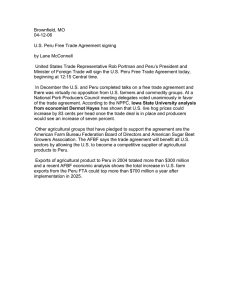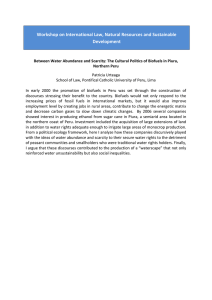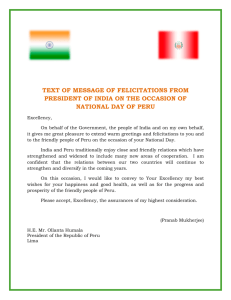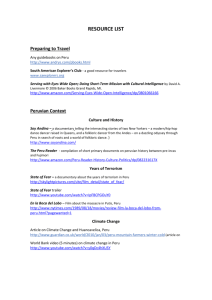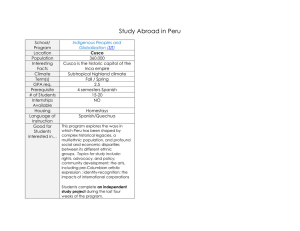AMERICAN UNIVERSITY
advertisement
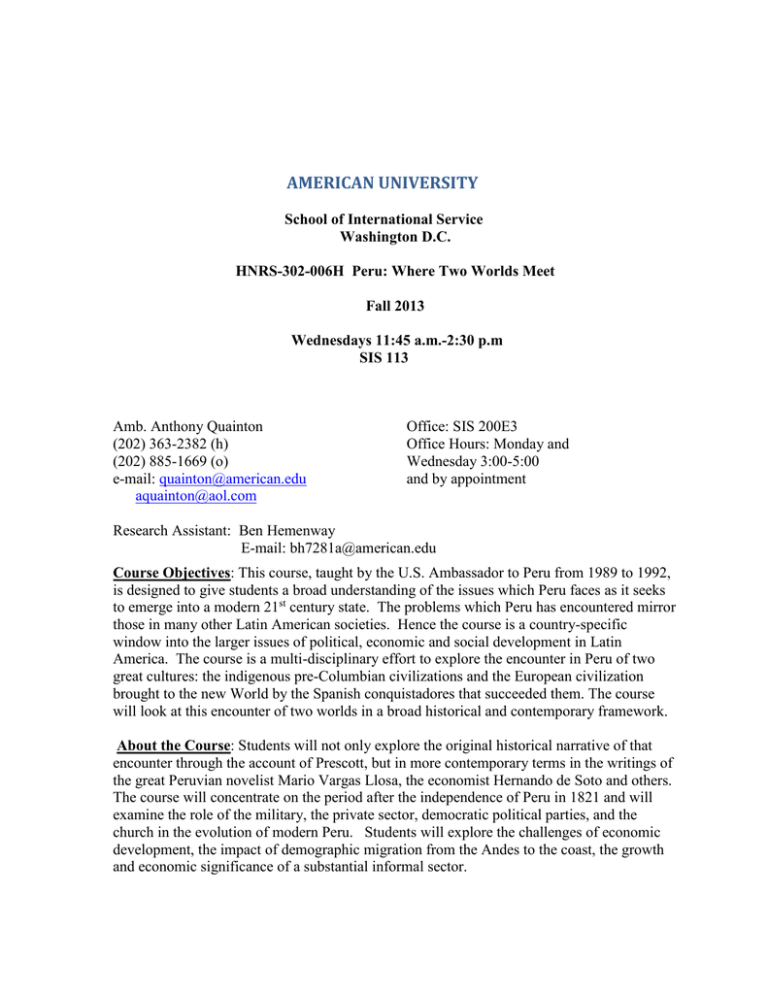
AMERICAN UNIVERSITY School of International Service Washington D.C. HNRS-302-006H Peru: Where Two Worlds Meet Fall 2013 Wednesdays 11:45 a.m.-2:30 p.m SIS 113 Amb. Anthony Quainton (202) 363-2382 (h) (202) 885-1669 (o) e-mail: quainton@american.edu aquainton@aol.com Office: SIS 200E3 Office Hours: Monday and Wednesday 3:00-5:00 and by appointment Research Assistant: Ben Hemenway E-mail: bh7281a@american.edu Course Objectives: This course, taught by the U.S. Ambassador to Peru from 1989 to 1992, is designed to give students a broad understanding of the issues which Peru faces as it seeks to emerge into a modern 21st century state. The problems which Peru has encountered mirror those in many other Latin American societies. Hence the course is a country-specific window into the larger issues of political, economic and social development in Latin America. The course is a multi-disciplinary effort to explore the encounter in Peru of two great cultures: the indigenous pre-Columbian civilizations and the European civilization brought to the new World by the Spanish conquistadores that succeeded them. The course will look at this encounter of two worlds in a broad historical and contemporary framework. About the Course: Students will not only explore the original historical narrative of that encounter through the account of Prescott, but in more contemporary terms in the writings of the great Peruvian novelist Mario Vargas Llosa, the economist Hernando de Soto and others. The course will concentrate on the period after the independence of Peru in 1821 and will examine the role of the military, the private sector, democratic political parties, and the church in the evolution of modern Peru. Students will explore the challenges of economic development, the impact of demographic migration from the Andes to the coast, the growth and economic significance of a substantial informal sector. The course is linked to the University Honors Program Study/Travel Abroad trip planned to Peru during the winter break. Students can register for the course and Study/Travel Abroad trip (one credit) separately. The trip will include meetings with American Embassy officials and a range of Peruvian leaders and academics to learn firsthand the challenges that Peru faces as it seeks to overcome the profound legacy of social, political and economic inequality created in the aftermath of the encounter between two great and distinct cultures more than 400 years ago. The students will also travel to Cuzco and Machu Picchu to see some of the greatest monuments of both Incan and colonial civilization in the Americas. Learning Outcomes At the end of the course students should - Be familiar with the principal events in Peruvian history and their significance Have an understanding of the tensions between different cultures/classes and races in Peru and their impact on both economic development and democracy promotion Be able to write a clearly focused paper highlighting the significance and policy implications of the subject reviewed Be able to make a concise, well-organized ten minute oral presentation supported by a Power Point display Be able to extrapolate to a wide Latin America context of the salient elements of the Peruvian experience Requirements: The success of the course will depend on the commitment and hard work of the students, who will be expected to develop and lead discussions, read and understand assigned readings and discuss their written work with the class. Class time will include short lectures by the professor, class discussion and presentations, and occasional outside speakers with professional experience in Peru. There will be a short mid-term examination on October 9 designed to test students’ knowledge of the salient events and personalities in Peruvian history. Each student will also be expected to write an eight page paper on some aspect of Peruvian history or institutions. That paper will be preceded by a short (5-7 minute) in-class presentation on the subject of the paper. Presentation/paper topics will be distributed on the first day of class. Papers are due two weeks after the in-class presentation. General class participation and the presentation will count for 20% of the final grade. The mid-term will count for 20%, the term paper 30% and the final exam 30%. Students who elect to take the winter break trip for credit will have to produce an additional 6-8 page paper on some aspect of their experience in Peru. Paper Requirements: All papers must meet the following minimum standards: Papers must be typewritten or printed double-spaced in a font size no smaller than 10 pt. The preferred font size is 12 pt. They may be printed on both sides of each sheet of paper. There should be a title, your name and the date of submission. This should be at the top of the first page, or on a separate title page. Either form is acceptable. Each page, except the first, needs to be numbered. Papers should have no grammatical or spelling errors Citations must be in a standard format. Either footnotes or endnotes are acceptable. When an author’s work is paraphrased, credit must be given to the author, preferably in the body of the paper as well as in a footnote/endnote. A quote used without quotation marks is plagiarism. Academic Integrity: Students are expected to abide by the Academic Integrity Code of American University (available online at www.american.edu/american/registrar/text/t_aic.html). Course Books The following books have been ordered and should be available through the campus bookstore. Assigned readings from them are listed after each week’s assignment. Students should read all of the assigned portions of these books. Additional material/articles are listed after these required readings and are posted on blackboard for each week of the course. Students are strongly encouraged to read as much of the supplementary material as possible. Cynthia McClintock and Fabian Vallas, The United States and Peru, Routledge, 2003. Orin Starn, Carlos Ivan Degregori and Robin Kirk, eds, The Peru Reader: History Culture and Politics Hernando de Soto, The Other Path, Basic Books. Daniel Masterson, History of Peru, Greenwood, 2008. Mario Vargas Llosa, Death in the Andes. Course Outline August 28: Introduction: Geography of Peru and Pre-Conquest History The following should, if possible be read before the first class, but certainly by the second. The Peru Reader, pp 13-91 William A. Prescott, The Conquest of Peru, Book I, Chapter 1 (on blackboard) September 4: The Conquistadores and Spanish Colonial Rule The Peru Reader, pp.93-173 William A. Prescott, The Conquest of Peru, Book III, Chapter 2 and Book IV, Chapter 5 (on blackboard) September 11: The Period of Independence, the War of the Pacific and the Beginning of Peruvian Democracy The Peru Reader. Pp 175-209 Class presentations on the Andean Pact and Peru’s Relations with Chile and Ecuador Daniel Gleason, “Anti-Democratic Thought in Early Republican Peru: Bartolome Herrera and Liberal-Conservative Ideological Struggle,” The Americas, Vol 38, No. 2 Thomas M. Davies, Jr., “‘Indian Integration in Peru,1820-1848: An Overview,” The Americas, Vol. 30, No 2. Michael J. Gonzales,” Neo-Colonialism and Indian Unrest in Southern Peru,1867-1898,” Bulletin of Latin American Research, Vol.6, No 1. September 18: Key Institutions: The Military and the Church The Peru Reader, pp 269-318 Jeffrey Klaiber, SJ, The Catholic Church in Peru pp 1-37,359-363 Jeffrey Klaiber, “The Catholic Lay Movement in Peru: 1867-1959”, The Americas, vol. 40, No.2 Cynthia McClintock, “Velasco, Officers and Citizens: The Politics of Stealth”, in The Peruvian Experiment Reconsidered, pp. 275- 308 Luis Pasara, “When the Military Dreams”, in The Peruvian Experiment Reconsidered, pp. 309343 Jane S. Jaquette, “Revolution by Fiat: The Context of Policy-Making in Peru”, The Western Political Quarterly, Vol.25, no. 4 Guillermo Rochabrun Silva and Anibal Yanez,” Democratization and Class Struggle”, Latin American Perspectives, Vol. 15, No. 3 Class presentations on the Catholic Church, Protestantism and the Institutional Role of the Military September 25: Political Parties and the Failure of Democracy The Peru Reader, pp 441-480 Jana Morgan Kelly, “Counting on the Past or Investing in the Future? Economic and Political Accountability in Fujimori’s Peru”, The Journal of Politics, Vol65, No.3 John McMillan and Pablo Zoido, “How to Subvert Democracy: Montesinos in Peru”, The Journal of Economic Perspectives, Vol. 18, No. 4 Jo-Marie Burt, “Quien Habla es Terrorista: The Political Use of Fear in Fujimori’s Peru”, Latin American Research Review, Vol. 41, No 3 Class Presentations on the Velasco Revolution, APRA and Political Parties October 2: Terrorism, Human Rights and the Breakdown of the Peruvian State The Peru Reader , pp. 319-406 Cynthia McClintock and Fabian Vallas, The United States and Peru, pp 131-156 Orin Starn, “Maoism in the Andes: The Communist Party of Peru- Shining Path and the Refusal of History”, Journal of Latin American Studies, Vol.27, no.2 David Scott Palmer,” Rebellion in Rural Peru: The Origins and Evolution of Sendero Luminoso”, Comparative Politics, Vol. 18, No.2 Orin Starn, “To Revolt against the Revolution: War and Resistance in Peru’s Andes”, Cultural Anthropology, Vol. 10, Nov, 4 Philip Mauceri,” Military Politics and Counter-Insurgency in Peru”, Journal of Interamerican Studies and World Affairs, Vol,.33, No 4 Eduardo Gonzalez –Cueva, “ Conscription and Violence in Peru”, Latin American Perspectives, Vol. 27, No.3 Class Presentations on Sendero Luminoso and Human Rights October 9: Mid Term Exam View: “The Fall of Fujimori” Class presentation on the Fujimori period. October 16. The War on Drugs The Peru Reader, pp. 407-440 Cynthia McClintock and Fabian Vallas, The United States and Peru . pp. 111-130 Isaias Rojas, “Peru: Drug Control Policy, Human Rights and Democracy” in Coletta Youngers and Eileen Rosin, Drugs and Democracy in Latin America, pp.185-230 David Scott Palmer, “Peru, the Drug Business and Shining Path: Between Scylla and Charybdis?” Journal of Interamerican Studies and World Affairs, Vol. 34, No.3 Class presentation on Drug Interdiction/Eradication and Alternative Development October 23: Peruvian Populism: Toledo , Garcia and Umala Peru Reader pp. 353-407 Robert R. Barr, “The Persistence of Neopopulism in Peru: From Fujimori to Toledo,” Third World Quarterly, Vol. 24, No.6 Kenneth M. Roberts, “Economic Crisis and the Demise of the Legal Left in Peru”, Comparative Politics, Vol.29, No. 1 Presentations on Social Inclusion and President Humala October 30: Overview of the Peruvian Economy – The Challenges of Development Cynthia Mcclintock and Fabian Vallas, The United States and Peru pp 91-110 De Soto, The Other Path, especially Chapters 1 and 5-8 Moises Arce, The sustainability of Economic Reform in a most Likely Case: Peru Michel Chossudovsky, “Under the Tutelage of IMF: The Case of Peru” Economic Weekly, Vol.27, No. 7 John Sheahan, “Effects of Liberalization Programs on Poverty and Inequality: Chile, Mexico and Peru”. Latin American Research Review, Vol.32, No 3 Presentation on Oil/Gas, Minerals, the Informal Economy and the US/Peru Free Trade Agreement November 6: Peruvian Culture Through the Lens of Film View Madeinusa Guest Speaker: Professor Jeff Middents, College of Arts and Sciences November 13: Modern Peruvian Culture: The vision of Mario Vargas Llosa Vargas Llosa, Death in the Andes Guest speaker: Dr. Robert Albro November 20: US Peruvian Relations Visit to Peruvian Embassy for briefing or Visiting Speaker from either the Peruvian Embassy or the State Department Cynthia McClintock and Fabian Vallas, The United States and Peru, pp. 1-90 and 157-169 Colleta Youngers, “The Collateral Damage of the U.S. War on Drugs: Conclusions and Recommendations”, in Drugs and Democracy in Latin America: the Impact of U.S. Policy, pp339-365 December 4: Summing Up: The Relevance of the Peruvian Experience for Latin America. December 16 : Final Examination January 2-12 Optional Trip to Lima, Cuzco and Machu Picchu.
